SUBJECTS
GRADE
Show Results
Book of Bones: 10 Record–Breaking Animals
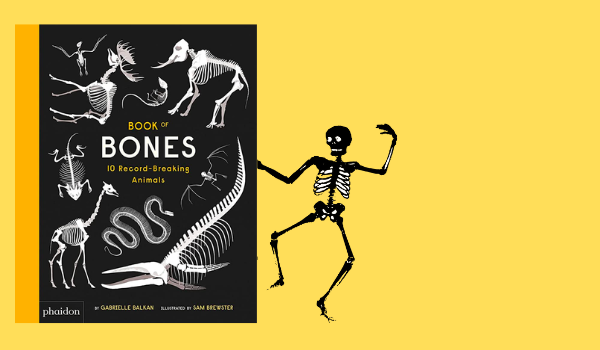
Lesson Summary
- Collaborate, improvise, create, choreograph, and perform a dance inspired by scientific information of a record-breaking animal.
- Interpret movement choices of other group performances.
Lesson Plan and Procedure
Lesson Key Facts
- Grade(s): 2, 3, 4
- Subject(s): Dance, English Language Arts, Science
- Duration of lesson: 4-6 sessions, 45 minutes each
- Author(s): Miriam Bowen
Teacher note: Before teaching this lesson, take time to read pages 48-49 to gain understanding of the author’s intent and the vocabulary used within the book. This will give you background knowledge of what is known and not known about animals, and of the creative choices made by the author of this book. You may also choose to read these pages to your students. This can encourage their scientific thinking, inquiries, and discoveries. Happy researching!
Book Introduction: “GUESS WHO KNOWS A LOT ABOUT BONES? YOU DO!”
Introduce the book title, author, and illustrator (information about the author and illustrator are at the back of the book and in Additional Resources below). Read the first two pages (4 and 5) and follow the invitation to have students locate a hard bone on their body such as their rib.
Teacher: “Guess who knows a lot about bones? You do!” Can you locate the tiny mouse in contrast to the enormous Tyrannosaurus Rex skeleton? Do you know which animal has the biggest bone in the world, and which has the smallest bone?
Teacher: One of the skills we will be practicing today is our ability to infer. To infer is to make a well-informed guess from one’s general life knowledge, combined with words and/or visual images. To help you make an inference, listen carefully to the words, and look closely at the illustrations to draw a conclusion as to which impressive animal goes with which special bone. This process will also help you gather information and ideas that can later be transferred into motion, as you make movement and shape choices for group choreography.
Whole Group Collaboration Activities
According to your objectives and time allotment, choose to read the information and explore movement with one to four of the first four animals presented within The Book of Bones as whole group activities.
Guess Who Has The Biggest Bone
Read pages 6 and 7. Have the students locate their mandible bone and fit it in the palm of their hand. Imagine how big 20 feet must be. Use a tape measure to see how far 20 feet is. You may also take time to explore the actual size of this animal's skull, or make comparisons with human bones. Invite students to imagine their finger bones (phalanges) being inside a flipper.
Teacher: Imagine your finger bones were inside a flipper. Try moving them in swimming ways as if you were moving through water.
Teacher: From what you have heard and seen; can you make an inference as to which animal has the biggest bone?
If they conclude a whale, invite them to go deeper to identify the specific whale. Turn the page to learn more information about the Blue Whale.
You can also turn off the lights and shine a flashlight through the back of the page to see the skeletal system of each record-breaking animal. This is also a textural book where the skeletal system can be felt on the color-illustrated page of each animal. This can be repeated with each of the ten animals.
Teacher: Our biggest bone is the femur bone, located under the hip and going down to the knee. Find a large shape using the whole body and accentuating the femur bone. When the music begins, try moving in big ways inspired by the words and illustrations we have heard and seen. To achieve large movement, elongate away from the core with a distal reach. When the music turns off, end in a large, interesting shape different from the first.
Vocabulary words to inspire large movement: huge, gigantic, tremendous, massive, great.
Distal: See the Dance Elements page
Music Suggestion:
- Largest Bone - Blue Whale - "North Easter" by: Cusco
Guess Who Has The Smallest Bone
Invite students to sit down and gather more visual and informational clues for the animal with the smallest bone. Read pages 10 and 11. Make the actual size comparisons in the text: eyelash, dot, pinky nail, paperclip, soup spoon, and raisin.
Teacher: From what you have heard and seen, can you make an inference as to which animal has the smallest bone? Let's turn the page to learn more about the Etruscan Shrew.
Teacher: Like the Etruscan Shrew we also have three small bones inside our ears; the hammer, anvil, and stirrup that vibrate allowing us to hear sound.
Teacher: To feel a vibration, place your top teeth against your lower lip and make the sound of the letter V. Say “vibrate.” Can you feel the vibration on your lip? Now place your hand on your neck and feel the vibrations that extend through your throat. Now try to create a vibration through your body by moving back and forth quickly, like a shiver when you are cold. Vibrating is the big job of our hammer, anvil, and stirrup bones to help us with our sense of hearing.
Teacher: Make a small beginning shape, with the pinky finger lifting. When the music begins, try moving only one pinky finger. Then add the other pinky finger and continue to add body parts while keeping the movement small. Small movement can be achieved on high, medium and low levels. To attain small movement on any level, keep movement close to the core/center.
Vocabulary words to inspire small movement: teeny, tiny, small, startled, shy, hide.
Core: See the Dance Elements page
Music Suggestion:
- Smallest Bones - Etruscan Shrew - “Salt" by Poppy Ackroyd
Guess Who Has The Most Bones
Invite students to sit down as you read pages 14 and 15. Follow the patterns as above
with the first two animals allowing students to share their guesses.
- Interact with the text in meaningful ways.
- Make inferences (guesses) using visual and textual clues.
- Check to see if guesses are correct.
- Create expressive movements inspired by visual images and scientific text.
Teacher: Like a Reticulated Python, each of us has a spine. Bend over and touch the center of your back to locate those hard knobs. Each knob is called a vertebra and adds up to make our flexible spine that helps us bend. Bend forward, backward, sideways and to the other side.
Vocabulary words to inspire flexible and snake-like movement: bend, slither, stretch, wind around, reach high, bend low, wiggle.
Energy: See the Dance Elements page
Music Suggestion:
- Most Bones - Reticulated Python - "Enchantress" by: Brent Lewis Enchantress
Guess Who Has The Longest Neck Bone
Once again, invite students to sit as you explore yet another record-breaking animal, reading pages 18 -19. Follow the pattern of interacting, inferring, checking, clarifying, and creating. Remind students that their movement exploration needs to begin and end with an interesting shape.
Teacher: Like a Reticulated Giraffe, each of us have seven vertebrae in our necks. Although ours are much smaller than those of the six-foot-long neck of the giraffe. Bend your head down to look at the floor and put your fingers in the center of your neck to locate your vertebra.
Vocabulary words to inspire giraffe-like movement: long, tall, saunter, reach, see far, kick.
Level: See the Dance Elements page
Music Suggestion:
- Longest Neck Bone - Reticulated Giraffe - "Rainbow Ribbons" by: Brent Lewis
Small Group Collaboration, Creation and Performances
Teacher Prep: Make a copy of Six Record-Breaking Animals for Group Collaboration and Choreography pdf.
- Number the students in a random order, 1-6. Have all the number ones gather, number twos, and so forth, until you have the class gathered into six groups.
- Choose a group leader and give them a clipboard with paper and pencil.
- Ask them to write the name of each group member including their own as leader.
- Have each group leader choose one of the six “record-breaking animal” papers from a container.
- Have the group leader write down their chosen animal and record the record-breaking bone it is known for.
- Have the group leader read the scientific information listed on the paper out loud to their group.
Take time to show each individual group the visual images of their animal found within the book. Guide them to look for potential movement or dance elements suggested by the illustrations that can be transferred into motion.
Collaboration
Teacher: As you work within your small group, each member will have an opportunity to contribute, communicate, collaborate, cooperate, and even compromise. Practicing these skills prepares you to work well with others in order to succeed.
Upload: Book of Bones.pptx
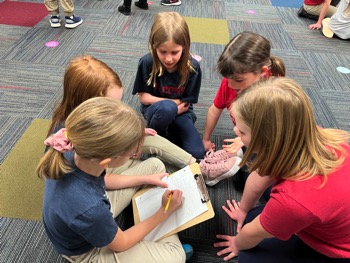
Slide 1: Instructions for Collaboration Activity
Teacher:
- Group leaders will assign a number to each member of the group.
- Each group member will have 30 seconds to share thoughts and ideas for a beginning or ending shape, or movement that can represent an aspect of the group’s chosen animal. While the speaker is talking, all other group members look at and listen to the speaker.
- Leaders will draw or write this idea on the planning paper with that member’s name next to it.
- To keep this a guessing game, try to talk quietly and keep your focus within your own group work.
Teacher: Here are some questions to support your brainstorming, collaborating, planning, creating, and choreographing:
Slide 2: Questions to Consider
Teacher:
- What did you see or notice?
- What thoughts and ideas have come from what you have seen and heard?
- What do you wonder about?
- What are movement or shape ideas that could represent your animal?
- How can our movement choices help our audience make an inference about our animal?
Move through this activity with each group member contributing an idea. You may need to coach quiet students through this process and/or remind a talkative student to listen as another shares.

Creation
Slide 3: Creation Time: Improvising and Choreographing
Teacher: You will be...Improvising: Playing with movement structures and concepts, or making up movement as you go...and Choreographing: Planning and arranging movements into a form with intent of making the movement the same each time.
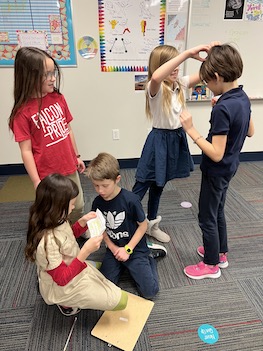
Slide 4: Preliminary Instructions
Teacher:
- What interesting shape or physical movement can go with each idea that each member of your group shared?
- Physically improvise and share your interesting shape and movement ideas.
- The outcome of your group collaboration will be to work together to create a choreographed dance, with a clear beginning, middle, and end.
- Each group member’s contribution will be used, and all movements and shapes need to be inspired by the animal facts.
Teacher: Remember that those watching the dance you create will be looking for movement clues to help them make an inference as to the animal that inspired your choreography.
Teacher: In your small groups, model what we did in our large class group at the beginning of the book. Play with the movement and shape ideas each group member has contributed. Once you find the shape and movements that best represent your scientific facts, then set it to be the same each time you do the dance.
Slide 5: Shape-Movements-Shape, Dance Instructions
Teacher: You will create a Shape-Movements-Shape Dance. It must include the following:
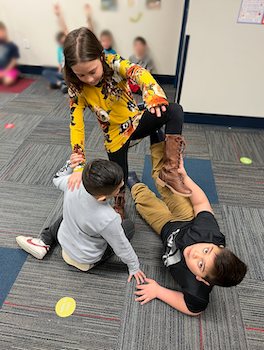
- A clear beginning, represented by an interesting shape.
- A detailed middle with three to five scientific facts of your selected animal represented through interesting movements.
- A clear ending represented by an interesting shape different from the first.
Allow as much time as possible for creating an interesting piece of choreography. Have leaders raise a hand when help is needed or side coach groups, as you see fit. Check for meaning and understanding by having the group members explain their choreographic choices and how they represent their animal’s record-breaking bone, with unique facts and movement qualities.
Group Performances
After students have had time to practice and feel comfortable with their choreography, let each group take a turn performing. This is the perfect setting to teach and establish:
Slide 6: Audience etiquette
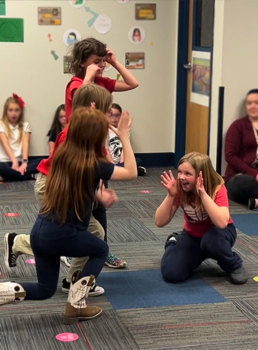
Teacher:
- Focus on the performers.
- Look closely at their shapes and movement choices to determine which animal they are representing through their dance.
- Cross your legs and keep your hands to yourself.
- Do not talk during each performance.
- Clap at the conclusion to show appreciation and respect for the performers.
Allow time at the end of each performance for reflection and commentary. Choose an audience member to make an inference and give specific reasons that guided them to that conclusion. According to your time allowance, choose one to three inferences from audience members. Have the performing group leader reveal the animal and its record-breaking bone that inspired the choreography. Clap again for the group and switch to another group, until all groups have had a turn performing with reflection following the performance.
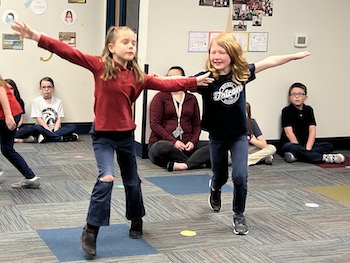
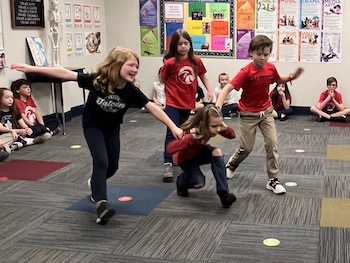
Celebration: Guess Who Else Has Special Bones
Read pages 46 and 47. Explore the comparisons of animal bones to human bones. Create a movement sequence or encourage students to improvise movement as you guide their attention to bone similarities. Have fun moving your bones and celebrating what you have learned and accomplished.
Music Suggestion:
- Justin Timberlake - Can't Stop The Feeling! [Lyrics]
Extended Activities
- Watch Alexandre Desplat *The Mirror*J T & Robert's, and interpret meaning, intent and artist purpose.
- After group performances, lead the whole class in movement exploration from each of the six animals that the groups have performed.
- Black light dance to Justin Timberlake - Can't Stop The Feeling! [Lyrics]
Learning Objectives
- Actively engage in reading and responding with purpose and understanding.
- Ask and answer questions to demonstrate understanding of a text.
- Create and perform an original dance with a beginning, middle and end.
- Identify words and ideas that can be demonstrated through movement.
- Build confidence and self-expression.
- Developing skills of contributing, communicating, collaborating, cooperating, and compromising to achieve success.
Utah State Board of Education Standards
This lesson can be used to meet standards in many grades and subject areas. We will highlight one grade’s standards to give an example of application.
Grade 2 (SEEd)
- Strand 2.2: LIVING THINGS AND THEIR HABITATS Living things (plants and animals, including humans) need water, air, and resources from the land to survive and live in habitats that provide these necessities. The physical characteristics of plants and animals reflect the habitat in which they live. Animals also have modified behaviors that help them survive, grow, and meet their needs. Humans sometimes mimic plant and animal adaptations to survive in their environment.
- Standard 2.2.1 Obtain, evaluate, and communicate information about patterns of living things (plants and animals, including humans) in different habitats. Emphasize the diversity of living things in land and water habitats. Examples of patterns in habitats could include descriptions of temperature or precipitation and the types of plants and animals found in land habitats. (LS2.C,LS4.C, LS4.D)
Grades 2 English Language Arts
- Standard 2.R.12: Demonstrate understanding of story elements and/or topics by applying information gained from illustrations or text features. (RL & RI)
- Standard 2.R.7: Describe how characters respond to major events and challenges. (RL) Describe the connection between a series of historical events, scientific ideas or concepts, or steps in technical procedures in a text. (RI)
- Standard 2.W.4
- Recall and gather information from provided sources to answer a question about the topic.
Grades 2 Fine Arts
- Strand: CREATE (2.D.CR.): Student’s will conceptualize, generate, develop and organize artistic ideas and work (Standards 2.D.CR.1-4).
Equipment and Materials Needed
- Book: Book of Bones 10 Record Breaking Animals by Gabrielle Balkan, Illustrated by Sam Brewster.
- Six Record-Breaking Animals for Group Collaboration and Choreography (Printed animal name, record-breaking bone, and scientific facts of six remaining animals).
- Dance Elements Page - Vocabulary
- Hand chime or drum and mallet.
- Music suggested or music of your own choice.
- Paper, pencils, clipboards, flashlight.
- Actual size items: ruler, measuring tape, paperclip, plastic teaspoon, raisin, jellybean, feather, single piece of spaghetti, cereal box.
Music Suggestions:
- Largest Bone - Blue Whale - "North Easter" by Cusco
- Smallest Bones - Etruscan Shrew - "Salt" by Yo-Yo Ma and Bobby McFerrin
- Most Bones - Reticulated Python - "Enchantress" by Brent Lewis
- Longest Neck Bone - Reticulated Giraffe - "Rainbow Ribbons" by Brent Lewis
- Heaviest Bone - African Bush Elephant - "Pachyderm Picnic" by Brent Lewis
- Lightest Bone - Peregrine Falcon - "Prelude To The Dance" by David Lanz
- Thinnest Bone - Bumblebee Bat - "Flight of the Bumblebee" by Rimsky Korsakov
- Fastest Growing Bone - Alaska Moose - "Mother Nature" by Natalie MacMaster
- Spikiest Bone - Regal Horned Lizard - "Buckwheat's Revenge" by Brent Lewis
- Fewest Bones - Great Hammerhead Shark - "True North" by Tristan Moore
- Special Bones - YOU - "Can't Stop The Feeling" by Justin Timberlake
Additional Resources
- BIO: Sam Brewster, Illustrator PDF
- Teachers Pay Teachers - Skeletons and Bones
- Book of Bones Resources
- Book Extensions:
- Book of Flight: 10 Record-Breaking Animals with Wings by Gabrielle Balkan, Sam Brewster Illustrator
- Book of Dinosaurs: 10 Record-Breaking Prehistoric Animals by Gabrielle Balkan, Sam Brewster Illustrator
- Bones: Skeletons and How They Work by Steve Jenkins
- Who’s Bones? An Animal Guessing Game by Gabrielle Balkan, Sam Brewster Illustrator
- Bones: An Inside Look at the Animal Kingdom by Jules Howard, Chervelle Fryer Illustrator
- Inside Animals by Barbara Taylor, Marguax Carpentier Illustrator
- An Anthology of Intriguing Animals DK books
- So Many Feet by Nicole Mara Alexander Vidal Santillanes Illustrator
- Extinct: An Illustrated Exploration of Animals That Have Disappeared by Lucas Riera
- Move! by Robin Page, Steve Jenkins Illustrator
- What Do You Do With A Tail Like This? by Robin Page, Steve Jenkins Illustrator
- Lovely Beasts: The Surprising Truth by Kate Gardner, Heidi Smith Illustrator
Image References
Images 1-8: Miriam Bowen

www.education.byu.edu/arts/lessons
 Download
Download